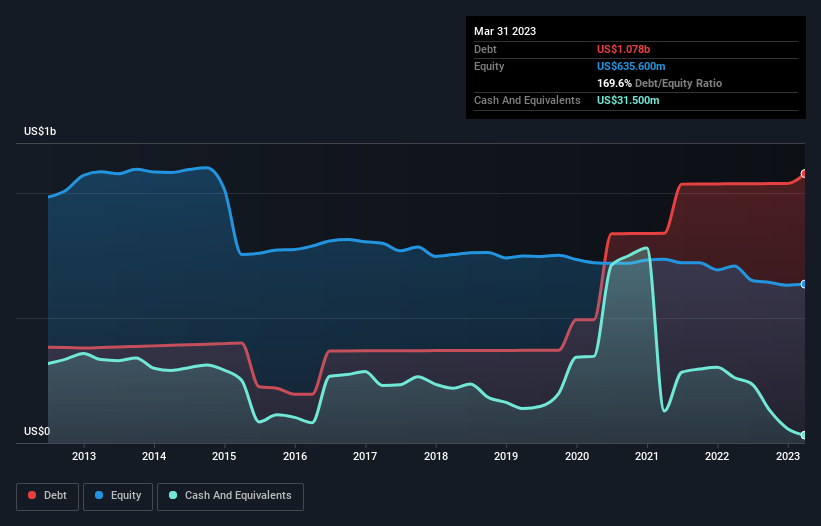- United States
- /
- Metals and Mining
- /
- NasdaqGS:KALU
Here's Why Kaiser Aluminum (NASDAQ:KALU) Is Weighed Down By Its Debt Load
Warren Buffett famously said, 'Volatility is far from synonymous with risk.' When we think about how risky a company is, we always like to look at its use of debt, since debt overload can lead to ruin. We note that Kaiser Aluminum Corporation (NASDAQ:KALU) does have debt on its balance sheet. But the real question is whether this debt is making the company risky.
When Is Debt Dangerous?
Debt and other liabilities become risky for a business when it cannot easily fulfill those obligations, either with free cash flow or by raising capital at an attractive price. Ultimately, if the company can't fulfill its legal obligations to repay debt, shareholders could walk away with nothing. However, a more usual (but still expensive) situation is where a company must dilute shareholders at a cheap share price simply to get debt under control. Of course, the upside of debt is that it often represents cheap capital, especially when it replaces dilution in a company with the ability to reinvest at high rates of return. When we think about a company's use of debt, we first look at cash and debt together.
Check out our latest analysis for Kaiser Aluminum
What Is Kaiser Aluminum's Net Debt?
The chart below, which you can click on for greater detail, shows that Kaiser Aluminum had US$1.08b in debt in March 2023; about the same as the year before. However, because it has a cash reserve of US$31.5m, its net debt is less, at about US$1.05b.

A Look At Kaiser Aluminum's Liabilities
The latest balance sheet data shows that Kaiser Aluminum had liabilities of US$405.9m due within a year, and liabilities of US$1.29b falling due after that. On the other hand, it had cash of US$31.5m and US$460.5m worth of receivables due within a year. So its liabilities total US$1.20b more than the combination of its cash and short-term receivables.
When you consider that this deficiency exceeds the company's US$1.10b market capitalization, you might well be inclined to review the balance sheet intently. In the scenario where the company had to clean up its balance sheet quickly, it seems likely shareholders would suffer extensive dilution.
In order to size up a company's debt relative to its earnings, we calculate its net debt divided by its earnings before interest, tax, depreciation, and amortization (EBITDA) and its earnings before interest and tax (EBIT) divided by its interest expense (its interest cover). Thus we consider debt relative to earnings both with and without depreciation and amortization expenses.
Weak interest cover of 0.42 times and a disturbingly high net debt to EBITDA ratio of 8.4 hit our confidence in Kaiser Aluminum like a one-two punch to the gut. This means we'd consider it to have a heavy debt load. Worse, Kaiser Aluminum's EBIT was down 80% over the last year. If earnings keep going like that over the long term, it has a snowball's chance in hell of paying off that debt. The balance sheet is clearly the area to focus on when you are analysing debt. But it is future earnings, more than anything, that will determine Kaiser Aluminum's ability to maintain a healthy balance sheet going forward. So if you're focused on the future you can check out this free report showing analyst profit forecasts.
Finally, while the tax-man may adore accounting profits, lenders only accept cold hard cash. So the logical step is to look at the proportion of that EBIT that is matched by actual free cash flow. Over the last three years, Kaiser Aluminum saw substantial negative free cash flow, in total. While that may be a result of expenditure for growth, it does make the debt far more risky.
Our View
To be frank both Kaiser Aluminum's conversion of EBIT to free cash flow and its track record of (not) growing its EBIT make us rather uncomfortable with its debt levels. And furthermore, its net debt to EBITDA also fails to instill confidence. Considering all the factors previously mentioned, we think that Kaiser Aluminum really is carrying too much debt. To our minds, that means the stock is rather high risk, and probably one to avoid; but to each their own (investing) style. The balance sheet is clearly the area to focus on when you are analysing debt. But ultimately, every company can contain risks that exist outside of the balance sheet. For example - Kaiser Aluminum has 2 warning signs we think you should be aware of.
If you're interested in investing in businesses that can grow profits without the burden of debt, then check out this free list of growing businesses that have net cash on the balance sheet.
Valuation is complex, but we're here to simplify it.
Discover if Kaiser Aluminum might be undervalued or overvalued with our detailed analysis, featuring fair value estimates, potential risks, dividends, insider trades, and its financial condition.
Access Free AnalysisHave feedback on this article? Concerned about the content? Get in touch with us directly. Alternatively, email editorial-team (at) simplywallst.com.
This article by Simply Wall St is general in nature. We provide commentary based on historical data and analyst forecasts only using an unbiased methodology and our articles are not intended to be financial advice. It does not constitute a recommendation to buy or sell any stock, and does not take account of your objectives, or your financial situation. We aim to bring you long-term focused analysis driven by fundamental data. Note that our analysis may not factor in the latest price-sensitive company announcements or qualitative material. Simply Wall St has no position in any stocks mentioned.
About NasdaqGS:KALU
Kaiser Aluminum
Manufactures and sells semi-fabricated specialty aluminum mill products.
Undervalued with solid track record and pays a dividend.
Similar Companies
Market Insights
Community Narratives



